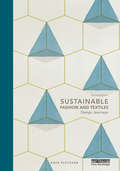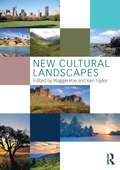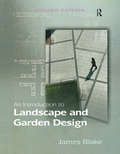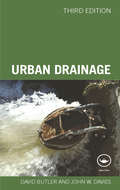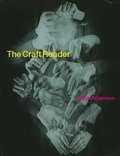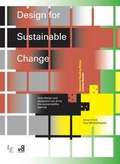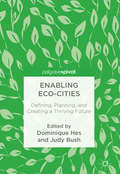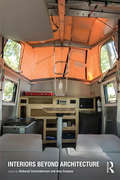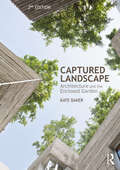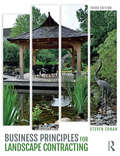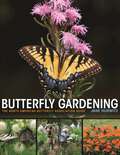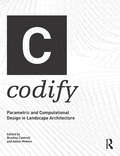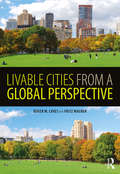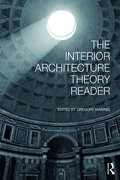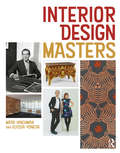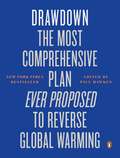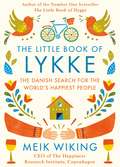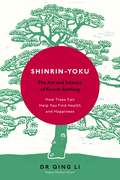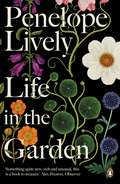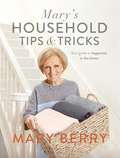- Table View
- List View
Sustainable Fashion and Textiles: Design Journeys
by Kate FletcherPraise for the previous edition: "[A] fascinating book." John Thackara, Doors of Perception "Provides the foundations for a radical new perspective." Ethical Pulse "At last a book that dispels the idea that fashion is only interested in trend-driven fluff: not only does it have a brain, but it could be a sustainable one." Lucy Siegle, Crafts Magazine ? Fully revised and updated, the second edition of Sustainable Fashion and Textiles: Design Journeys continues to define the field of design in fashion and textiles. Arranged in two sections, the first four chapters represent key stages of the lifecycle: material cultivation/extraction, production, use and disposal. The remaining four chapters explore design approaches for altering the scale and nature of consumption, including service design, localism, speed and user involvement. While each chapter is complete in and of itself, their real value comes from what they represent together: innovative ways of thinking about textiles and garments based on sustainability values and an interconnected approach to design. Including a new preface, updated content and a new conclusion reflecting and critiquing developments in the field, as well as discussing future developments, the second edition promises to provide further impetus for future change, sealing Sustainable Fashion and Textiles: Design Journeys as the must-buy book for fashion and textiles professionals and students interested in sustainability.
Sustainable Fashion and Textiles: Design Journeys
by Kate FletcherPraise for the previous edition: "[A] fascinating book." John Thackara, Doors of Perception "Provides the foundations for a radical new perspective." Ethical Pulse "At last a book that dispels the idea that fashion is only interested in trend-driven fluff: not only does it have a brain, but it could be a sustainable one." Lucy Siegle, Crafts Magazine ? Fully revised and updated, the second edition of Sustainable Fashion and Textiles: Design Journeys continues to define the field of design in fashion and textiles. Arranged in two sections, the first four chapters represent key stages of the lifecycle: material cultivation/extraction, production, use and disposal. The remaining four chapters explore design approaches for altering the scale and nature of consumption, including service design, localism, speed and user involvement. While each chapter is complete in and of itself, their real value comes from what they represent together: innovative ways of thinking about textiles and garments based on sustainability values and an interconnected approach to design. Including a new preface, updated content and a new conclusion reflecting and critiquing developments in the field, as well as discussing future developments, the second edition promises to provide further impetus for future change, sealing Sustainable Fashion and Textiles: Design Journeys as the must-buy book for fashion and textiles professionals and students interested in sustainability.
New Cultural Landscapes
by Maggie Roe Ken TaylorWhile historical and protected landscapes have been well studied for years, the cultural significance of ordinary landscapes is now increasingly recognised. This groundbreaking book discusses how contemporary cultural landscapes can be, and are, created and recognised. The book challenges common concepts of cultural landscapes as protected or ‘special’ landscapes that include significant buildings or features. Using case studies from around the world it questions the usual measures of judgement related to cultural landscapes and instead focuses on landscapes that are created, planned or simply evolve as a result of changing human cultures, management policy and practice. Each contribution analyses the geographical and human background of the landscape, and policies and management strategies that impact upon it, and defines the meanings of 'cultural landscape' in its particular context. Taken together they establish a new paradigm in the study of landscapes in all forms.
New Cultural Landscapes
by Maggie Roe Ken TaylorWhile historical and protected landscapes have been well studied for years, the cultural significance of ordinary landscapes is now increasingly recognised. This groundbreaking book discusses how contemporary cultural landscapes can be, and are, created and recognised. The book challenges common concepts of cultural landscapes as protected or ‘special’ landscapes that include significant buildings or features. Using case studies from around the world it questions the usual measures of judgement related to cultural landscapes and instead focuses on landscapes that are created, planned or simply evolve as a result of changing human cultures, management policy and practice. Each contribution analyses the geographical and human background of the landscape, and policies and management strategies that impact upon it, and defines the meanings of 'cultural landscape' in its particular context. Taken together they establish a new paradigm in the study of landscapes in all forms.
An Introduction to Landscape and Garden Design
by James BlakeHow do you design a landscape book suitable for its intended uses? How can the natural qualities of a landscape be enhanced with new features and focal points? How can you make pedestrians stay on the footpath? What kind of plant, path or wall should you put where, and what sort of contract should you choose for your client's contractor? This refreshingly down-to-earth introduction to the vast subject of landscape design and construction answers all these questions, guiding new students through the many facets of professional practice and welding together the artistic, legal, financial, environmental and management issues which can seem so dauntingly disconnected. Illustrated with original drawings, photographs, sample plans and facsimiles, including a new colour plate section, this readable classic has been fully revised and updated throughout. It opens with a completely new chapter which explains design and aesthetic principles, explores the history of our relationship to landscape, and shows how design principles can be applied to influence reactions to the finished site. The author then considers different elements of hard landscape and their relative merits in different situations. The soft landscape section includes coverage of the effects of mass and form, natural and abstract planting, and the difficult subject of plant selection. A step-by-step guide through all the stages of managing a project, from initial discussions with clients, site inspection, surveying and quoting, through tendering, contracting, contractual agreements, development from concept design to final plans and drawings, as well as maintenance, now includes the current information on CDM regulations and provides readers with a plain-speaking reference on client management and contractual administration. Added to the guide to drawing and lettering is an extensive section on computer-aided design. A bibliography and list of useful organization are also included.
Urban Drainage, Third Edition
by David Butler John DaviesUrban Drainage has been thoroughly revised and updated to reflect changes in the practice and priorities of urban drainage. New and expanded coverage includes: Sewer flooding The impact of climate change Flooding models The move towards sustainability Providing a descriptive overview of the issues involved as well as the engineering principles and analysis, it draws on real-world examples as well as models to support and demonstrate the key issues facing engineers dealing with drainage issues. It also deals with both the design of new drainage systems and the analysis and upgrading of existing infrastructure. This is a unique and essential textbook for students of water, environmental, and public health engineering as well as a valuable resource for practising engineers.
Urban Drainage, Third Edition
by David Butler John DaviesUrban Drainage has been thoroughly revised and updated to reflect changes in the practice and priorities of urban drainage. New and expanded coverage includes: Sewer flooding The impact of climate change Flooding models The move towards sustainability Providing a descriptive overview of the issues involved as well as the engineering principles and analysis, it draws on real-world examples as well as models to support and demonstrate the key issues facing engineers dealing with drainage issues. It also deals with both the design of new drainage systems and the analysis and upgrading of existing infrastructure. This is a unique and essential textbook for students of water, environmental, and public health engineering as well as a valuable resource for practising engineers.
The Craft Reader (PDF)
by Glenn AdamsonFrom the canonical texts of the Arts and Crafts Movement to the radical thinking of today's "DIY" movement, from theoretical writings on the position of craft in distinction to Art and Design to how-to texts from renowned practitioners, from feminist histories of textiles to descriptions of the innovation born of necessity in Soviet factories and African auto-repair shops...The Craft Reader presents the first comprehensive anthology of writings on modern craft. Covering the period from the Industrial Revolution to today, the Reader draws on craft practice and theory from America, Europe, Asia and Africa. The world of craft is considered in its full breadth -- from pottery and weaving, to couture and chocolate-making, to contemporary art, architecture and curation. The writings are themed into sections and all extracts are individually introduced, placing each in its historical, cultural and artistic context. Bringing together an astonishing range of both classic and contemporary texts, The Craft Reader will be invaluable to any student or practitioner of Craft and also to readers in Art and Design. AUTHORS INCLUDE: Theodor Adorno, Anni Albers, Amadou Hâmpaté Bâ, Charles Babbage, Roland Barthes, Andrea Branzi, Alison Britton, Rafael Cardoso, Johanna Drucker, Charles Eames, Salvatore Ferragamo, Kenneth Frampton, Alfred Gell, Walter Gropius, Tanya Harrod, Martin Heidegger, Patrick Heron, Bernard Leach, Esther Leslie, W. R. Lethaby, Lucy Lippard, Adolf Loos, Karl Marx, William Morris, Robert Morris, László Moholy-Nagy, Stefan Muthesius, George Nakashima, Octavio Paz, Grayson Perry, M. C. Richards, John Ruskin, Raphael Samuel, Ellen Gates Starr, Debbie Stoller, Alexis de Tocqueville, Lee Ufan, Frank Lloyd Wright.
Design For Sustainable Change (PDF)
by Anne Chick Paul MicklethwaiteDesign for Sustainable Change explores how design thinking and design-led entrepreneurship can address the issue of sustainability, examining how familiar design processes can be translated into methodologies for driving sustainable change in businesses, organisations and society more generally. It discusses the ways in which design thinking is evolving and being applied to a much wider spectrum of social and environmental issues, beyond its traditional professional territory. The result is designers themselves evolving, and developing greater design mindfulness in relation to what they do and how they do it. This book looks at design thinking as a methodology which, by its nature, considers issues of sustainability, but which does not necessarily seek to define itself in those terms. It explores the gradual extension of this methodology into the larger marketplace and the commercial and social implications of such an extension.
Enabling Eco-Cities: Defining, Planning, and Creating a Thriving Future
by Dominique Hes Judy BushCities are striving to become more resilient, adaptive and sustainable; this requires new ways of governing and developing the city. This book features chapters by researchers using regenerative development and transitions theories to envisage how Eco-Cities could be planned, designed and created, and concludes with practical tools and an outline of how this evolution could be facilitated. It examines two major questions: How can we use understandings of Eco-Cities to address the legacy of urban built form and existing practices which often make it difficult to create the systemic changes needed? And what are the elements of complex urban places and spaces that will enable the planning, creation and evolution of thriving cities?The book will appeal to planners, city makers, urban researchers, students and practitioners, including planners, designers, architects and sustainability managers, and all those seeking to envisage the steps along the path to thriving cities of the future.
Enabling Eco-Cities: Defining, Planning, and Creating a Thriving Future
by Dominique Hes Judy BushCities are striving to become more resilient, adaptive and sustainable; this requires new ways of governing and developing the city. This book features chapters by researchers using regenerative development and transitions theories to envisage how Eco-Cities could be planned, designed and created, and concludes with practical tools and an outline of how this evolution could be facilitated. It examines two major questions: How can we use understandings of Eco-Cities to address the legacy of urban built form and existing practices which often make it difficult to create the systemic changes needed? And what are the elements of complex urban places and spaces that will enable the planning, creation and evolution of thriving cities?The book will appeal to planners, city makers, urban researchers, students and practitioners, including planners, designers, architects and sustainability managers, and all those seeking to envisage the steps along the path to thriving cities of the future.
Interiors Beyond Architecture
by Deborah Schneiderman Amy CamposInteriors Beyond Architecture proposes an expanded impact for interior design that transcends the inside of buildings,?analysing significant interiors that engage space outside of the disciplinary boundaries of architecture. It presents contemporary case studies from a historically nuanced and theoretically informed perspective, presenting a series of often-radical propositions about the nature of the interior itself. Internationally renowned contributors from the UK, USA and New Zealand present ten typologically specific chapters including: Interiors Formed with Nature, Adaptively Reused Structures, Mobile Interiors, Inhabitable art, Interiors for Display and On Display, Film Sets, Infrastructural Interiors, Interiors for Extreme Environments, Interior Landscapes, and Exterior Interiors.
Captured Landscape: Architecture and the Enclosed Garden
by Kate BakerThe enclosed garden, or hortus conclusus, is a place where architecture and landscape come together. It has a long and varied history, ranging from the early paradise garden and cloister, the botanic garden and giardini segreto, the kitchen garden and as a stage for social display. The enclosed garden has continued to develop into its many modern forms: the city retreat, the redemptive garden, the deconstructed building. As awareness of climate change becomes increasingly important, the enclosed garden, which can mediate so effectively between interior and exterior, provides opportunities for sustainable design and closer contact with the natural landscape. By its nature it is ambiguous. Is it an outdoor room, or captured landscape; is it architecture or garden? Kate Baker discusses the continuing relevance of the typology of the enclosed garden to contemporary architects by exploring influential historical examples and the concepts they generate, alongside some of the best of contemporary designs – brought to life with vivid photography and detailed drawings – taken primarily from Britain, the Mediterranean, Japan and North and South America. She argues that understanding the potential of the enclosed garden requires us to think of it as both a design and an experience. Captured Landscape provides a broad range of information and design possibilities for students of architectural and landscape design, practising architects, landscape designers and horticulturalists and will also appeal to a wider audience of all those who are interested in garden design. This second edition of Captured Landscape is enriched with new case studies throughout the book. The scope has now been broadened to include an entirely new chapter concerning the urban condition, with detailed discussions on issues of ecology, sustainability, economy of means, well-being and the social pressures of contemporary city life.
Business Principles for Landscape Contracting
by Steven CohanBusiness Principles for Landscape Contracting, fully revised and updated in its third edition, is an introduction to the application of business principles of financial management involved in setting up your own landscape contracting business and beginning your professional career. Appealing to students and professionals alike, it will build your knowledge of financial management tools and enable you to relate their applications to real-life business scenarios. Focusing on the importance of proactive financial management, the book serves as a primer for students in landscape architecture, contracting, and management courses and entrepreneurs within the landscape industry preparing to use business principles in practice. Topics covered include: Financial management and accountability Budget development Profitable pricing and estimating Project management Creating a lean culture Personnel management and employee productivity Professional development Economic sustainability.
Butterfly Gardening: The North American Butterfly Association Guide
by Jane HurwitzAn indispensable and lavishly illustrated guide to creating a garden that attracts and sustains butterfliesButterfly gardening creates habitats that support butterflies, connecting us with some of the most beautiful creatures in the natural world and bringing new levels of excitement and joy to gardening. In this engaging and accessible guide, lavishly illustrated with more than two hundred color photographs and maps, accomplished butterfly gardener Jane Hurwitz presents essential information on how to choose and cultivate plants that will attract a range of butterflies to your garden and help sustain all the stages of their life cycles. An indispensable resource for aspiring and experienced butterfly gardeners alike, Butterfly Gardening is the most gardener-friendly source on the subject, covering all the practical details needed to create a vibrant garden habitat that fosters butterflies. It tells you which plants support which butterflies, depending on where you live; it describes what different butterflies require in the garden over the course of their lives; and it shows you how to become a butterfly watcher as well as a butterfly gardener.While predominantly recommending regionally native plants, the book includes information on non-native plants. It also features informative interviews with experienced butterfly gardeners from across the United States. These gardeners share a wealth of information on plants and practices to draw butterflies to all kinds of gardens--from small suburban gardens to community plots and larger expanses.Whether you are a gardener who wants to see more butterflies in your garden, a butterfly enthusiast who wants to bring that passion to the garden, or someone who simply wants to make their garden or yard friendlier to Monarchs or other butterflies, this is a must-have guide.An essential guide for aspiring and experienced butterfly gardenersEncourages readers to rethink gardening choices to support butterflies and other pollinators in their gardens and communitiesIntroduces gardeners to butterfly watchingIncludes regional lists of plant species that are time-proven to help sustain butterflies and their caterpillarsFeatures informative interviews with expert butterfly gardeners from across the United States
Codify: Parametric and Computational Design in Landscape Architecture
by Bradley Cantrell Adam MekiesCodify: Parametric and Computational Design in Landscape Architecture provides a series of essays that explore what it means to use, modify and create computational tools in a contemporary design environment. Landscape architecture has a long history of innovation in the areas of computation and media, particularly in how the discipline represents, analyses, and constructs complex systems. This curated volume spans academic and professional projects to form a snapshot of digital practices that aim to show how computation is a tool that goes beyond methods of representation and media. The book is organized in four sections; syntax, perception, employ, and prospective. The essays are written by leading academics and professionals and the sections examine the role of computational tools in landscape architecture through case studies, historical accounts, theoretical arguments, and nascent propositions.
Codify: Parametric and Computational Design in Landscape Architecture
by Bradley Cantrell Adam MekiesCodify: Parametric and Computational Design in Landscape Architecture provides a series of essays that explore what it means to use, modify and create computational tools in a contemporary design environment. Landscape architecture has a long history of innovation in the areas of computation and media, particularly in how the discipline represents, analyses, and constructs complex systems. This curated volume spans academic and professional projects to form a snapshot of digital practices that aim to show how computation is a tool that goes beyond methods of representation and media. The book is organized in four sections; syntax, perception, employ, and prospective. The essays are written by leading academics and professionals and the sections examine the role of computational tools in landscape architecture through case studies, historical accounts, theoretical arguments, and nascent propositions.
Livable Cities from a Global Perspective
by Roger W. Caves Fritz WagnerLivable Cities from a Global Perspective offers case studies from around the world on how cities approach livability. They address the fundamental question, what is considered "livable?" The journey each city has taken or is currently taking is unique and context specific. There is no such thing as a one-size-fits-all approach to livability. Some cities have had a long history of developing livability policies and programs that focus on equity, economic, and environmental concerns, while other cities are relatively new to the game. In some areas, government has taken the lead while in other areas, grassroots activism has been the impetus for livability policies and programs. The challenge facing our cities is not simply developing a livability program. We must continually monitor and readjust policies and programs to meet the livability needs of all people. The case studies investigate livability issues in such cities as Austin, Texas; Helsinki, Finland; London, United Kingdom; Warsaw, Poland; Tehran, Iran; Salt Lake City, United States; Rio de Janeiro, Brazil; Sydney, Australia; and Cape Town, South Africa. The chapters are organized into such themes as livability in capital city regions, livability and growth and development, livability and equity concerns, livability and metrics, and creating livability. Each chapter provides unique insights into how a specific area has responded to calls for livable cities. In doing so, the book adds to the existing literature in the field of livable cities and provides policy makers and other organizations with information and alternative strategies that have been developed and implemented in an effort to become a livable city.
The Interior Architecture Theory Reader
by Gregory MarinicThe Interior Architecture Theory Reader presents a global compilation that collectively and specifically defines interior architecture. Diverse views and comparative resources for interior architecture students, educators, scholars, and practitioners are needed to develop a proper canon for this young discipline. As a theoretical survey of interior architecture, the book examines theory, history, and production to embrace a full range of interior identities in architecture, interior design, digital fabrication, and spatial installation. Authored by leading educators, theorists, and practitioners, fifty chapters refine and expand the discourse surrounding interior architecture.
Interior Design Masters
by Mark Hinchman Elyssa YonedaInterior Design Masters contains 300 biographical entries of people who have significantly impacted design. They are the people, historical and contemporary, that students and practitioners should know. Coverage starts in the late Renaissance, with a focus on the twentieth and twenty-first centuries. The book has five sections, with the entries alphabetical in each, so it can serve as a history textbook and a reference guide. The seventeeth- and eighteenth-century section covers figures from Thomas Chippendale to Horace Walpole. The nineteenth-century section includes William Morris and Candace Wheeler. The early twentieth-century section presents modernism’s design heroes, including Marcel Breuer, Eileen Gray, and Gilbert Rohde. The post-World War II designers range from Madeleine Castaing to Raymond Loewy. The final contemporary section includes Ron Arad and the Bouroullec brothers. These are the canonical figures who belong to any design history. The book also contains less well-known figures who deserve attention, such as Betty Joel, the British art deco furniture designer; Paul Veysseyre, the Frenchman active in China in the 1930s; and more recently Lanzavecchia-Wai, the Italian-Singaporean duo whose work ranges from health care to helicopters. Global in its coverage, the book is richly illustrated with over 600 black-and-white and color photographs.
Drawdown: The Most Comprehensive Plan Ever Proposed to Reverse Global Warming
by Paul HawkenNEW YORK TIMES BESTSELLERFor the first time ever, an international coalition of leading researchers, scientists and policymakers has come together to offer a set of realistic and bold solutions to climate change. All of the techniques described here - some well-known, some you may have never heard of - are economically viable, and communities throughout the world are already enacting them. From revolutionizing how we produce and consume food to educating girls in lower-income countries, these are all solutions which, if deployed collectively on a global scale over the next thirty years, could not just slow the earth's warming, but reach drawdown: the point when greenhouse gasses in the atmosphere peak and begin todecline. So what are we waiting for?
The Little Book of Lykke: The Danish Search for the World's Happiest People
by Meik WikingLykke (Luu-kah) (n): Happiness It's easy to see why Denmark is often called the world's happiest country. Not only do they have equal parental leave for men and women, free higher education and trains that run on time, but they burn more candles per household than anywhere else.So nobody knows more about happiness - what the Danes call lykke - than Meik Wiking, CEO of the Happiness Research Institute in Copenhagen and author of the bestselling sensation The Little Book of Hygge. But he believes that, whilst we can certainly learn a lot from the Danes about finding fulfilment, the keys to happiness are actually buried all around the globe.In this captivating book, he takes us on a treasure hunt to unlock the doors to inner fulfilment. From how we spend our precious time, to how we relate to our neighbours and cook dinner, he gathers evidence, stories and tips from the very happiest corners of the planet. This is the ultimate guide to how we can all find a little more lykke in our lives.
Shinrin-Yoku: The Art and Science of Forest Bathing
by Dr Qing LiShinrin = Forest Yoku = Bathing Shinrin-Yoku or forest bathing is the practice of spending time in the forest for better health, happiness and a sense of calm. A pillar of Japanese culture for decades, Shinrin-Yoku is a way to reconnect with nature, from walking mindfully in the woods, to a break in your local park, to walking barefoot on your lawn. Forest Medicine expert, Dr Qing Li's research has proven that spending time around trees (even filling your home with house plants and vaporising essential tree oils) can reduce blood pressure, lower stress, boost energy, boost immune system and even help you to lose weight. Along with his years of ground-breaking research, anecdotes on the life-changing power of trees, Dr Li provides here the practical ways for you to try Shinrin-Yoku for yourself.
Life in the Garden
by Penelope Lively'Rich and unusual, a book to treasure. Few recent gardening books come anywhere close to its style, intelligence and depth. Moves between Lively's own horticultural life and a broad history of gardening' Observer'Wonderful. A manifesto of horticultural delight' Literary Review'Beautiful. Perfect for literary garden lovers' Good Housekeeping'Exquisite and original' Daily Telegraph 'Enchanting. Reading this book is like walking with a wise, humorous guide through a series of garden rooms . . . and finding that vistas suddenly open out, on to history, fashion, politics, reflections on time and the taming of nature' Tablet'A perfect bedside book. In part it's a memoir of the gardens in Lively's life, starting with the exotic Egyptian garden of her childhood and continuing up to her small present-day garden in a north London square' Sunday Express'A gentle survey of the garden's place in Western culture, which morphs into a personal meditation on time, memory and a life well lived' i'Scholarly bedtime reading' The Times, Books of the Year
Mary's Household Tips and Tricks: Your Guide to Happiness in the Home
by Mary BerryOne of the Guardian's TOP TEN BOOKS to gift. 'It's practical AND beautiful . . . an ideal gift' Graham Norton, BBC Radio 2Britain's best-loved cook and national treasure Mary Berry lets readers in on her very own household secrets . . . A comprehensive, beautifully illustrated guide that shares her greatest tips on how to care for your home. 'This book is a collection of skills I've learned for running a home. Gleaned from years of practical experience, along with all the hints that friends and family have imparted to me, I hope it will be a helping hand' - Mary BerryInside you'll find . . . A KITCHEN KNOW-HOW for the heart of your home - Freezer tips - Organize your food - CLEANING & CONFIGURING YOUR HOME - Create cleaning products from store cupboard items - LAUNDRY & WARDROBE WISDOM - Banish moths from your home for good - Remove stains from every kind of fabric - get green fingered with GARDENING & FLOWERS - Bring greenery into your home even without a garden - Create beautiful flower arrangements - And finally master the art of HOSTING & ADDING THE EXTRA TOUCHES for sparkling parties at home.Easy to use, practical and gorgeously illustrated, Mary's Household Tips & Tricks covers everything from Mary's golden rules for baking to her favourite flowers for each season, from how to polish silver to whether tea should be poured before or after milk. With secrets for accomplishing the most challenging home-keeping tasks with ease, Mary's wonderfully simple book will help turn any house into a home.'The Queen of British baking has whipped up a recipe for home happiness' The Independent'A domestic goddess' The Daily Telegraph
